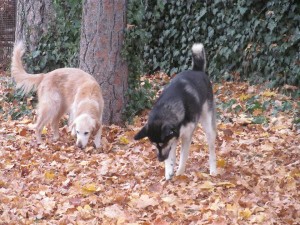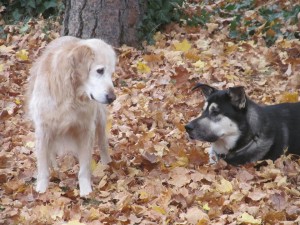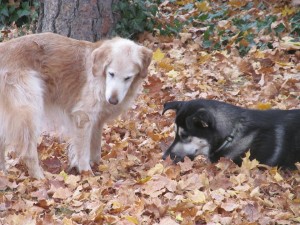
Calming signals are facial expressions and body postures that dogs use to communicate with each other that they intend no harm. With calming signals, one dog says to another, “I am no threat to you.”
Safety means survival to dogs; instinct tells them the best way to survive is not to fight in the first place.
I was lucky enough recently to get some photos of two dogs and their calming signals. It happened in my own back yard! One dog is older—a 14-year-old golden retriever with a lifetime of experience around other dogs and people. The second dog is younger—not yet two, but with the solid background of a great puppy class and continued training and socialization. They have known each other since the younger was a puppy. In adulthood, the younger dog—a mix of shepherd and husky—towers over the golden retriever, outweighing him by 40 pounds.
The two dogs were playing in my yard. I threw a tennis ball for my golden retriever but, as often happens this time of year, it got lost in the leaves near the back fence. Both dogs went tearing after the ball but when they got to where they thought it should be, couldn’t easily find it. Caught up in the chase, there they were, suddenly close to each other without prior planning.
Here they’re standing together, both very close to where the ball is, both wanting to find the ball but—more important—both knowing it would be best not to “find the ball” at the same time the other dog “finds the ball.” A collision would result! Neither dog has any intention of fighting for the ball or of fighting at all. They know instinctively it’s in their own best interests not to get physical.

The golden’s posture demonstrates one of the most common calming signals: the curvy body. You can see how he has posed himself, tail curved, body curved, head pointing slightly away from the younger dog. That posture shows the younger dog that the golden is not poised to leap forward—not poised for any action, really, except to sniff the ground . . . which is an additional calming signal.
The younger dog’s posture is centered on the ball—or at least on where he thinks he spots the ball. Although he is angled slightly toward the golden, everything about him shows full concentration on the ball and no concentration on the other dog. Of course, he can see every move the other dog makes, out of the corner of his eye, and the golden can see him, too, though neither one is looking at the other. Remember, looking away is a very strong calming signal.
Close contact here. As I mentioned, they have known each other most of the younger dog’s life, so this is not unusual behavior for them. However, the older dog is certainly aware of how things have changed since the younger one was a puppy. First, the older dog is less physically able, following surgery early this year to have a back toe removed (a result of an infection that went up into the bone from a torn toenail). He is also . . . older. Second, the younger dog has grown huge. He is very strong and very heavy (not one ounce overweight, either) and, since he is young, his actions could still be somewhat unpredictable.
In the photo, you see the younger dog saying, “I respect you, I like you, I am no threat to you,” and the older dog responding, “I know. I am not afraid.”

Back to the ball, still hidden in the leaves—the younger dog is now closer to it. (I was pretty sure when I took the photo that the ball was right under the younger dog’s nose.) I think he’s telling the golden, “It’s right here, buddy, but I’m not going to dive for it. I’m not even looking at it. Are you?” The golden appears to me (and I know him pretty well because he’s mine) to be saying, “I know where the ball is, too, young fellow. Let’s not bump heads over it, okay?” They are both willing to wait!

Simple enough—they both know where the ball is, but they’re still negotiating over who might pick it up. This scene went on for several minutes, with both of them moving very slowly, never taking their peripheral vision off each other but also never looking each other in the eye. The husky mix: “I know it’s there. I can see it through the leaves. I know you see it.” The golden: “I see it. Chill.”

They seem to have made the decision. It’s better to stay still and avoid conflict. Our safety with each other is much more important than picking up a ball. This is exemplary behavior for two dogs who are friends. Imagine yourself and a friend in a similar situation, but say the ball is . . . a piece of your favorite cake? Both you and your friend see the one piece of cake, want the one piece of cake, but you’re not willing to argue over it because that might affect your friendship. You offer your friend the cake, your friend says, “Oh, no, I couldn’t,” and you end up compromising. Half the cake for each of you.
Curvy body, looking away, lying down—all calming signals these two dogs used to maintain the peace. I especially appreciate the way the much bigger, much younger dog “self-handicapped” when interacting with his older, somewhat smaller friend. “I will make myself smaller,” he seems to have thought. The two dogs ended up spending an idyllic afternoon together, chasing the ball and running around in the leaves. Later, they even played together physically, with the younger one lying down for most of it.
Calming signals. For more information online, try Googling: what is my dog saying?
Next, calming signals you can learn to use, with your own dog and with dogs you meet.



